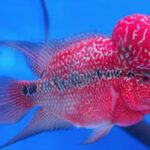With their vibrant colors, unique kok patterns, and almost alien-like appearance, Thai Silk Flowerhorn cichlids have become hugely popular in the aquarium trade. Their pearlescent scales shimmer under the aquarium lights, showing off shades of metallic blue, pink, and even purple.
But these stunning fish require more specialized care than many beginner species. This complete care guide covers everything you need to know about keeping healthy, happy Thai Silk Flowerhorns.
Origins of the Thai Silk Flowerhorn
Flowerhorn cichlids are man-made hybrids that first appeared in Malaysia and Taiwan in the 1990s. Breeders crossed species like the Trimac, Red Devil, and Blood Parrot to intensify coloration and amplify the signature kok or nuchal hump on the fish’s forehead.
The Thai Silk Flowerhorn is a newer color morph that resulted from carefully selective breeding programs. Their unique patterns and pearlescent sheen quickly made them popular in the ornamental fish trade.
While still hybrids, Thai Silks have a more streamlined appearance than traditional Flowerhorns. They exhibit vivid metallic colors that shimmer and change under lighting. Most display pink, purple, and blue hues over a bright white body. The iconic kok often matches the main body color.
Housing Considerations for Thai Silk Flowerhorns
As cichlids, Thai Silks tend to be aggressive and territorial. They require ample tank space and robust water parameters. Here are some key housing considerations:
– Tank Size – Aim for at least a 55-75 gallon aquarium. Larger is always better for these active cichlids.
– Substrate – Use smooth, medium grain sand substrate. Gravel risks damaging their chin brush.
– Hideouts – Floating and cave hides give them a sense of security and reduce aggression.
– Plants – Silk plants or tough species like Anubias and Java Fern are less prone to uprooting.
– Tankmates – Best kept alone or with similarly sized, aggressive tankmates. Avoid slow, fin-nipping fish.
Strong water flow and efficient filtration are also vital to mimic their original riverine environment. External canister filters paired with spray bar outputs provide the best results.
Optimal Water Parameters
Consistent, high-quality water keeps Thai Silk Flowerhorns looking their best. Here are the ideal parameters to maintain:
– Temperature – 78-82°F. Monitor with an accurate aquarium thermometer.
– pH – Slightly alkaline, between 7.4-8.0.
– Hardness – Moderately hard around 10-15 KH/GH. Helps amplify their coloring.
– Nitrates – Less than 20 ppm. Keep down through regular partial water changes.
Use chemical filtration media like activated carbon to remove organics and odors. Perform 25% weekly water changes religiously to replenish minerals and reduce nitrate accumulation.
Thai Silk Flowerhorn Dietary Needs
In nature, Flowerhorns forage on insects, crustaceans and smaller fish. Recreate this varied diet with commercial preparations in captivity:
– Protein-rich Foods – Feed high protein flakes, pellets, frozen and freeze dried options. High meat or spirulina content best.
– Treat Foods – Occasionally offer bloodworms, brine shrimp or crickets as treats. Sparingly, as these lack nutritional balance over the long term.
– Veggie Options – Sinkable aquatic veggie tabs, wafers or blanched zucchini provide fiber.
– No Live Foods – Despite their aggressive reputation avoid feeder fish, which introduce disease risks.
Feed juveniles 2-3 small meals daily. Adults can eat daily, but avoid bloating with a single larger feeding. Flake or pellet foods designed specifically for large, carnivorous cichlids deliver balanced nutrition.
Social, Reproductive & Health Behaviors
Thai Silk Flowerhorns exhibit some intriguing behaviors you should understand before venturing into their care:
– Aggression – High, especially toward tankmates. Reduce through ample space, hiding spots and one male per tank.
– Activity Level – High, especially at dawn/dusk. Expect energetic bursts around feeding times.
– Compatibility – Generally poor. Best housed alone or with equally large, aggressive cichlid species.
– Breeding – Difficult in home aquaria. Requires expert hand breeding techniques; fry susceptible without intensive care.
On the health front, pay particular attention for signs of stress like clamped fins, ragged breathing or loss of appetite. Skin flukes and gill parasites can also afflict Thai Silks shipped through the ornamental trade.
Investing in a striking Thai Silk Flowerhorn means committing to a long term (10+ years) care responsibility. Their initial purchase price proves just a small fraction of properly housing and feeding one of these visually arresting but demanding tropical cichlids.
Still can’t get enough? Check out this clip showcasing a magnificent adult Thai Silk Flowerhorn going through its feeding routine:
Let Us Know If You Have Any Other Thai Silk Flowerhorn Questions!
Their glittering scales and inflated cranial crests give Thai Silk Flowerhorns undeniable wow factor. But they require ample room, robust conditions and expert care to truly thrive.
Hopefully this care guide gave you a comprehensive overview for successfully keeping one of these magnificent hybrid cichlids. Let us know in the comments if you have any other questions about properly housing, feeding or breeding Thai Silk Flowerhorns!

Louis Vu, the Lead Writer at TanknFish.com, holds a Master’s degree in Marine Biology and brings over 6 years of expertise in the world of aquatics and fish care. With a profound passion for aquatic life, Louis is committed to delivering insightful and practical advice to help enthusiasts maintain vibrant and healthy fish tanks. Connect with Louis on social media: Instagram and Pinterest


